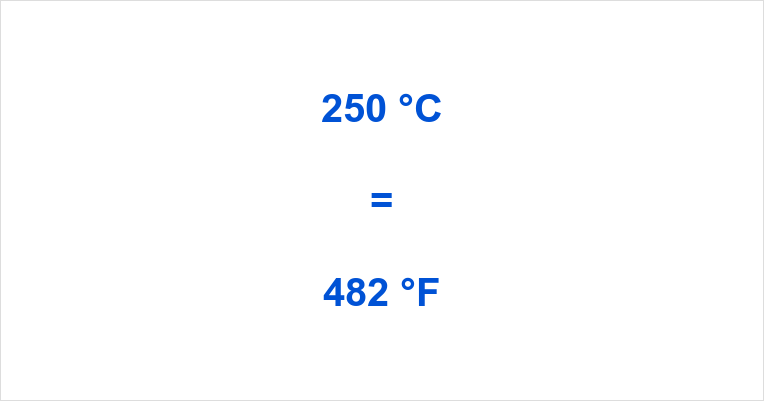250 Grader Celsius to Fahrenheit: The Ultimate Conversion Guide (Without the Math Meltdown)

Ever stumbled across a recipe, a DIY project, or a car repair manual that demands you to know what 250 grader Celsius is in Fahrenheit? You’re not alone. Between metric system lovers and imperial die-hards, navigating temperature conversions can feel like trying to decode hieroglyphics.
But don’t stress. Today, we’re serving up the ultimate, no-sweat guide to converting 250°C to Fahrenheit, plus everything else you need to understand Celsius vs Fahrenheit in the real world. 📚🔥
Let's dive in — trendy style. 🕶️
Quick Answer: What is 250 Grader Celsius in Fahrenheit?
Drumroll, please... 🥁
250°C equals 482°F.
Yep, you read that right! A smoking hot 482 degrees Fahrenheit. Whether you're baking pizza, tuning an engine, or setting up a high-temp industrial process, now you know.
But Wait, How Did We Get There?
It’s not magic — it’s just a simple formula that’s been around for centuries:
[ °F = (°C \times \frac{9}{5}) + 32 ]
Applying it:
[ (250 \times \frac{9}{5}) + 32 = (450) + 32 = 482°F ]
Boom. Math explained without a headache. 🎯
Pro Tip: If you’re working fast and loose, you can also estimate by doubling the Celsius temperature and adding 30. It won’t be 100% perfect, but it gets you close in a pinch.
Celsius vs Fahrenheit: Why So Different?
If you’ve ever wondered why some people are chilling at 20 degrees while others are shivering at 68, it all comes down to two totally different temperature scales.
- Celsius is based on the freezing point (0°C) and boiling point (100°C) of water. Super scientific, super logical. 📈
- Fahrenheit is based on a (kind of random) scale invented by Daniel Gabriel Fahrenheit in 1724, where 32°F is the freezing point of water and 212°F is the boiling point. (Britannica, 2024)
So when you're working with 250 grader Celsius, you’re operating at a crazy high temp that would have Daniel Fahrenheit shaking in his 18th-century boots.
Where Might You Encounter 250°C in Real Life?
1. Baking or Roasting
If you're whipping up some artisan sourdough bread or brick-oven pizza, you’ll see recipes calling for oven temps around 230–250°C (450–482°F). High-heat baking creates that killer crust everyone craves. 🍕🔥
2. Automotive Repairs
Car engines and exhaust systems operate at high temps. Engine bay temperatures often hit 250°C under load, especially in performance cars (Car and Driver, 2023).
3. Industrial and Scientific Applications
Heat treatments, metalwork, and laboratory tests sometimes require precise temps around 250°C for material transformations.
Translation: Understanding this conversion can save you serious headaches — or serious cash — if you work in these fields.
Common Conversion Mistakes to Avoid
Even pros sometimes slip up. Here’s what you want to watch out for:
🚫 Forgetting to Add 32
Doubling Celsius alone isn’t enough. Always remember that +32 offset for Fahrenheit.
🚫 Confusing °C with °F
Mixing up which scale you’re working with can destroy your cooking, your DIY projects, or even your car’s engine. Always double-check!
🚫 Relying on Memory Alone
Unless you're Rain Man, don’t try to remember random conversion numbers. Use a calculator, smartphone, or a handy chart.
Fast Temperature Conversion Chart: Celsius to Fahrenheit
| Celsius (°C) | Fahrenheit (°F) |
|---|---|
| 100°C | 212°F |
| 150°C | 302°F |
| 200°C | 392°F |
| 250°C | 482°F |
| 300°C | 572°F |
📌 Save this chart to your phone. It’ll make you look like a genius at your next dinner party. 😎
Fun Fact: Why Doesn’t Everyone Just Use Celsius?
Good question! Most of the world — about 95% — uses Celsius because it aligns neatly with the metric system. Logical, clean, and easy to work with.
But Fahrenheit is still kicking in the United States and a few other places because:
- It offers finer temperature gradations for everyday weather.
- It's deeply embedded in culture, recipes, and industries.
- Change is hard (and expensive).
Real talk: Celsius makes more sense scientifically. But Fahrenheit often feels "warmer" — psychologically, it just hits differently (National Weather Service, 2023).
Final Thoughts: Master Celsius to Fahrenheit Like a Boss
If you remember nothing else from this post, remember this:
- 250 grader Celsius = 482 Fahrenheit.
- Use the simple formula: multiply by 9/5, then add 32.
- Celsius is logical; Fahrenheit is cultural.
Next time your oven, car manual, or mechanic buddy throws Celsius numbers at you, you’ll flex your conversion skills like an absolute legend. 🚀
No panic. No guessing. Just smooth, cool confidence — even when the temperatures are hot as heck.
References:
- Autos
- Art
- Causes
- Crafts
- Dance
- Drinks
- Film
- Fitness
- Food
- Games
- Gardening
- Health
- Home
- Literature
- Music
- Networking
- Other
- Party
- Religion
- Shopping
- Sports
- Theater
- Wellness
